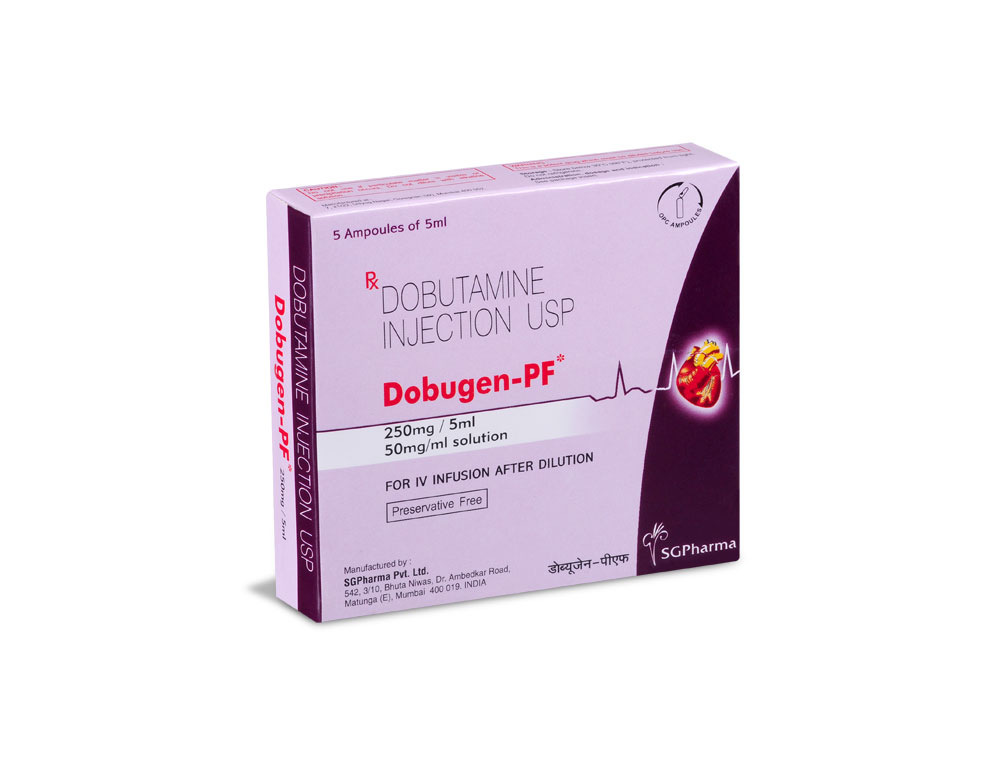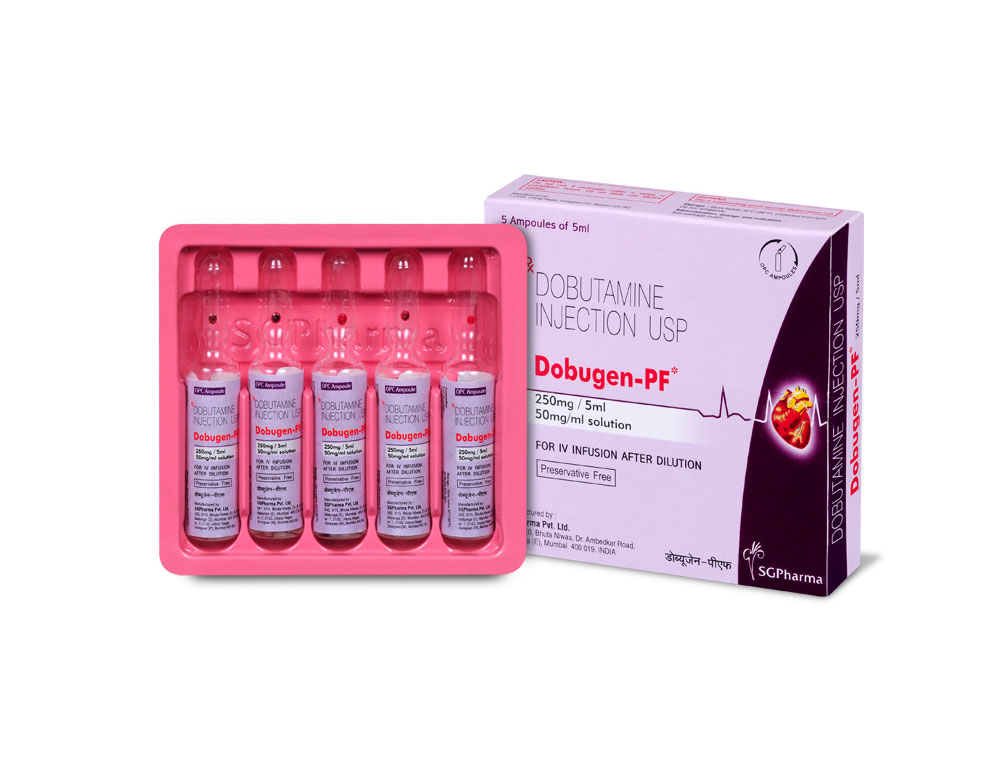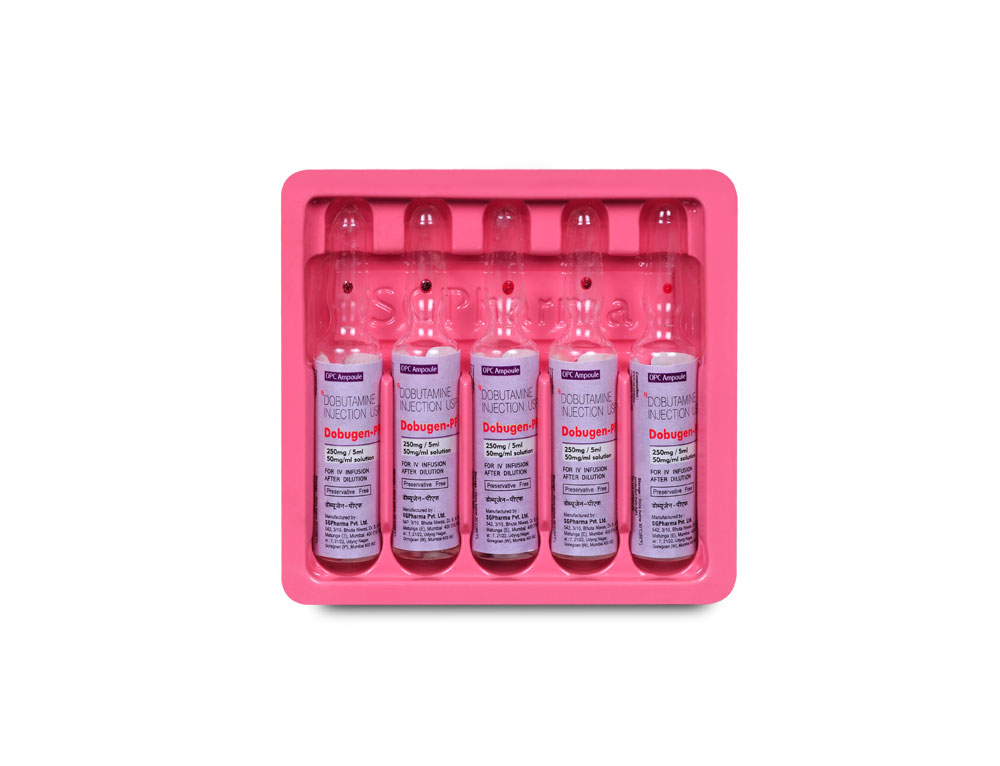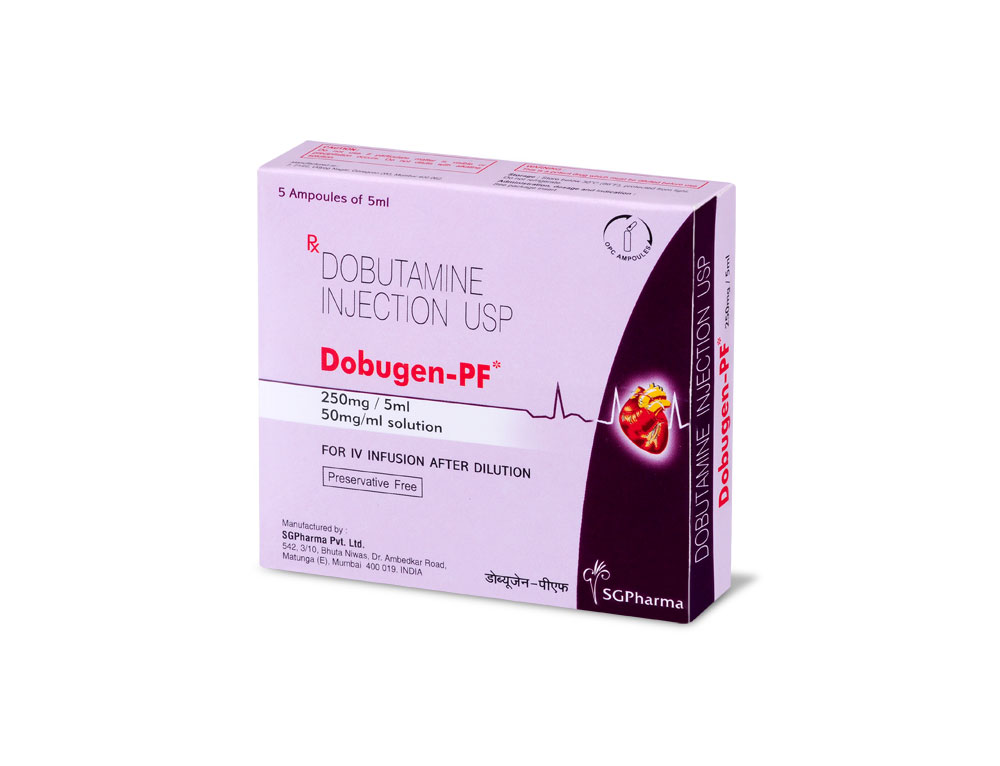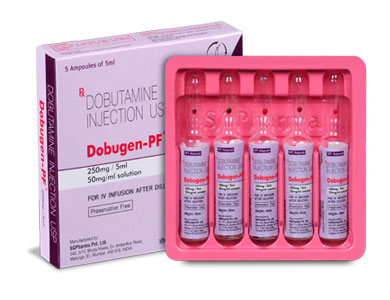
250 mg/5 ml
For the use of a Registered Medical Practitioner or a Hospital or a Institution only.
DOBUGEN-PF (Dobutamine Hydrochloride) is a synthetic catecholamine with α-1, β-1 and β-2 agonist activity. Chemically, Dobutamine HCl is (±)-4-[2-[[3-(p-Hydroxyphenyl)-1-methylpropyl]amino]ethyl]-pyrocatechol hydrochloride. The molecular formula is C18H23NO3.HCl and its molecular weight is 337.85.
STRUCTURAL FORMULA :
Its structural formula is :
-Structure.jpg)
DOBUGEN-PF is a clear colourless to pale yellow solution filled in 5 ml flint ampoules. It contains no preservatives.
COMPOSITION :
DOBUGEN-PF
For Ampoule of 5 ml
Each ml contains :
Dobutamine HCl USP
equivalent to Dobutamine 50 mg
Water for Injections I.P. q.s.
ACTIONS :
Dobutamine is a direct-acting inotropic agent whose primary activity results from stimulation of the β-receptors of the heart while producing comparatively mild chronotropic, hypertensive, arrhythmogenic, and vasodilative effects. Alteration of synaptic concentrations of catecholamines with either Reserpine or tricyclic antidepressants does not alter the actions of Dobutamine in animals, which indicates the actions of Dobutamine are not dependent on presynaptic mechanisms. It does not cause the release of endogenous Norepinephrine, as does dopamine. In animal studies, Dobutamine produces less increase in heart rate and less decrease in peripheral vascular resistance for a given inotropic effect than does Isoproterenol. In patients with depressed cardiac function, both Dobutamine and Isoproterenol increase the cardiac output to a similar degree. In the case of Dobutamine, this increase is usually not accompanied by marked increases in heart rate (although tachycardia is occasionally observed) and the cardiac stroke volume is usually increased. In contrast, Isoproterenol increases the cardiac index primarily by increasing the heart rate while stroke volume changes little or declines. Facilitation of atrioventricular conduction has been observed in human electrophysiological studies and in patients with atrial fibrillation.
Systemic vascular resistance is usually decreased with administration of Dobutamine. Occasionally, minimum vasoconstriction has been observed. Most clinical experience with Dobutamine is short-term not more than several hours in duration. In the limited number of patients who were studied for 24, 48 and 72 hours, a persistent increase in cardiac output occurred in some, whereas output returned towards baseline values in others.
PHARMACOKINETICS :
Although the onset of action of Dobutamine is within 1 to 2 minutes, as much as 10 minutes may be required to reach steady state plasma concentrations and peak effects with any given infusion rate. Steady state plasma concentrations are linearly related to infusion rates. At an infusion rate of 5 µg/(kg.min), the mean plasma concentration is approximately 100 ng/ml in patients with congestive heart failure. Plasma clearance of Dobutamine in humans in 2.4 I/min/m2, the volume of distribution is about 20 % of body weight and plasma elimination half-time is less than 3 minutes. The principal routes of disposition include methylation followed by conjugation. The 3-0-methyl derivative is inactive. Partial tolerance to Dobutamine develops during prolonged continuous infusions and becomes statistically significant at 72 hours. The cardiac output response to a constant infusion of Dobutamine at 72 hours is over 70 % of that obtained at the end of 2 hours in patients with congestive heart failure. This phenomenon may be caused by a decrease (down-regulation) in the number of β-adrenergic receptors. Alteration of synaptic concentrations of catecholamines with either Reserpine or tricyclic antidepressants does not alter the actions of Dobutamine in animals; Dobutamine acts directly and its effects are not dependent on presynaptic
mechanisms.
INDICATIONS :
DOBUGEN-PF is indicated when parenteral therapy is necessary for inotropic support in the short-term treatment of adults with cardiac decompensation due to depressed contractility resulting either from organic heart disease or from cardiac surgical procedures. In patients who have atrial fibrillation with rapid ventricular response, a digitalis preparation should be used prior to institution of therapy with DOBUGEN-PF.
Note : Do not add DOBUGEN-PF to 5 % Sodium Bicarbonate Injection or to any other strongly alkaline solution such as Aminophylline, Frusemide and Thiopentone Sodium. Because of potential physical incompatibilities, it is recommended DOBUGEN-PF not to be mixed with other drugs in the same solution. DOBUGEN-PF should not be used in conjunction with other agents or diluents containing both Sodium Bisulfite and Ethanol.
Administration :
DOBUGEN-PF must be diluted prior to administration. Because of its short half-life, DOBUGEN-PF must be administered as a continuous intravenous infusion. Following the initiation of a constant rate infusion, or upon changing the rate, a steady-state Dobutamine plasma concentration is achieved within approximately 10 minutes. Thus, loading doses or bolus injections are not necessary and are not recommended.
INSTRUCTIONS FOR USE OF AMPOULE (5 ml) :
The ampoule used in this product is equipped with O.P.C (One Point Cut) opening system. No ampoule file is needed to open the ampoule. The neck of the ampoule is prescored at the point of constriction. A coloured dot on the ampoule head helps to orientate the ampoule. Take the ampoule and face the coloured dot. Let the solution at the head of the ampoule to flow down by shaking or a gentle stroke. The ampoule opens easily by placing the thumb on the coloured dot and gently pressing downwards as shown.

Adults :
Recommended dosage :
The rates of fluid infusion that are required to deliver specific dosages are a function of the concentration of DOBUGEN-PF in the infusate. The following table provides a guideline of infusion rates (ml/(kg.min)) required for three frequently used concentrations of DOBUGEN-PF (250, 500 and 1,000 mcg/ml) in order to deliver the drug dosages which are indicated in the left hand column of the table.
-Table.jpg)
DOBUGEN-PF is contraindicated in patients with idiopathic hypertrophic subaortic stenosis and in patients who have shown previous manifestations of hypersensitivity to Dobutamine.
WARNINGS :
1. Increase in Heart Rate or Blood Pressure :
Dobutamine may cause a marked increase in heart rate or blood pressure, especially systolic pressure. Approximately 10 % of adult patients in clinical studies have had rate increases of 30 beats/minute or more and about 7.5 % have had a 50 mm Hg or greater increase in systolic pressure. Usually, reduction of dosage promptly reverses these effects. Because DOBUGEN-PF facilitates atrioventricular conduction, patients with atrial fibrillation are at risk of developing rapid ventricular response. In patients who have atrial fibrillation with rapid ventricular response, a digitalis preparation should be used prior to institution of therapy with DOBUGEN-PF. Patients with pre-existing hypertension appear to face an increased risk of developing an exaggerated pressor response.
3. Hypersensitivity :
Reactions suggestive of hypersensitivity associated with administration of DOBUGEN-PF, including skin rash, fever, eosinophilia and bronchospasm have been reported occasionally.
Usage in Pregnancy : Pregnancy category B
Reproduction studies performed in rats and rabbits have revealed no evidence of impaired fertility, harm to the foetus or teratogenic effects due to DOBUGEN-PF. However, the drug has not been administered to pregnant women and should be used only when the expected benefits clearly outweigh the potential risks to the foetus.
Labour and Delivery :
The effect of DOBUGEN-PF on labour and delivery is unknown.
Nursing Mothers :
It is not known whether DOBUGEN-PF crosses the placenta or is excreted in breast milk. Because many drugs are excreted in human milk, caution should be exercised when DOBUGEN-PF is administered to a nursing woman. If a mother requires treatment with DOBUGEN-PF, breast feeding should be discontinued for the duration of treatment.
Paediatric Use :
DOBUGEN-PF has been shown to increase cardiac output and systemic pressure in paediatric patients of every age group. In premature neonates, however, DOBUGEN-PF is less effective than Dopamine in raising systemic blood pressure without causing undue tachycardia and Dobutamine has not been shown to provide any added benefit when given to such infants already receiving optimal infusions of Dopamine.
INTERACTION AND INCOMPATIBILITY :
There was no evidence of drug interactions in clinical studies in which DOBUGEN-PF was administered concurrently with other drugs, including digitalis preparations, Furosemide, Spironolactone, Lidocaine, Nitroglycerin, Isosorbide Dinitrate, Morphine, Atropine, Heparin, Protamine, Potassium Chloride, Folic Acid and Acetaminophen. Preliminary studies indicate the concomitant use of Dobutamine and Nitroprusside results in a higher cardiac output and usually, a lower pulmonary wedge pressure than when either drug is used alone. Animal studies indicate Dobutamine may be ineffective if the patient has recently received a β-blocking drug. In such a case, the peripheral vascular resistance may increase.
SIDE EFFECTS :
Increased Heart Rate, Blood Pressure and Ventricular Ectopic Activity :
A 10 to 20-mm increase in systolic blood pressure and an increase in heart rate of 5 to 15 beats/minute have been noted in most patients. Approximately 5 % of patients have had increased premature ventricular beats during infusions. These effects are dose related.
Hypotension :
Precipitous decreases in blood pressure have occasionally been described in association with DOBUGEN-PF therapy. Decreasing the dose or discontinuing the infusion typically results in rapid return of blood pressure to baseline values. In rare cases, however, intervention may be required and reversibility may not be immediate.
Reactions at sites of intravenous infusion :
Phlebitis has occasionally been reported. Local inflammatory changes have been described following inadvertent infiltration. Isolated cases of cutaneous necrosis have been reported.
Miscellaneous uncommon effects :
The following adverse effects have been reported in 1 % to 3 % of patients : nausea, headache, anginal pain, non-specific chest pain, palpitations and shortness of breath. Isolated cases of thrombocytopenia have been reported. Administration of DOBUGEN-PF, like other catecholamines, can produce a mild reduction in serum potassium concentration, rarely to hypokalemic levels.
OVERDOSAGES :
Overdoses of DOBUGEN-PF have been reported rarely. The following is provided to serve as a guide if such an overdose is encountered.
Signs and Symptoms :
Toxicity from DOBUGEN-PF is usually due to excessive cardiac β-receptor stimulation. The duration of action of DOBUGEN-PF is generally short (T½ = 2 minutes) because it is rapidly metabolized by catechol-O-methyltransferase. The symptoms of toxicity may include anorexia, nausea, vomiting, tremor, anxiety, palpitations, headache, shortness of breath and anginal and nonspecific chest pain. The positive inotropic and chronotropic effects of DOBUGEN-PF on the myocardium may cause hypertension, tachyarrhythmias, myocardial
ischemia and ventricular fibrillation. Hypotension may result from vasodilation. If the product is ingested, unpredictable absorption may occur from the mouth and the gastrointestinal tract.
TREATMENT OF OVERDOSAGE :
In managing overdosage, consider the possibility of multiple drug overdoses, interaction among drugs, and unusual drug kinetics in the patient. The initial actions to be taken in a DOBUGEN-PF overdose are discontinuing administration, establishing an airway and ensuring oxygenation and ventilation. Resuscitative measures should be initiated promptly. Severe ventricular tachyarrhythmias may be successfully treated with Propranolol or Lidocaine. Hypertension usually responds to a reduction in dose or discontinuation of therapy. Protect the patient’s airway and support ventilation and perfusion. If needed, meticulously monitor and maintain, within acceptable limits, the patient’s vital signs, blood gases, serum electrolytes, etc. Absorption of drugs from the gastrointestinal tract may be decreased by giving activated charcoal, which, in many cases, is more effective than emesis or lavage; consider charcoal instead of or in addition to gastric emptying. Repeated doses of charcoal over time may hasten elimination of some drugs that have been absorbed. Safeguard the patient’s airway when employing gastric emptying or charcoal.
PHARMACEUTICAL PRECAUTIONS :
Parenteral drug products should be inspected visually for particulate matter and discoloration prior to administration, whenever solution and container permit. Solutions containing Dobutamine may exhibit pink colour. This colour change is due to slight oxidation of the drug, but there is no significant loss of potency, that if present, will increase with time.
STORAGE :
Store below 30°C (86°F), protected from light.
Do not refrigerate.
SHELF LIFE :
24 months from the date of manufacture.
PRESENTATION :
DOBUGEN-PF is supplied as 250 mg Dobutamine in 5 ml ampoule as aqueous solution. Such 5 ampoules of 5 ml are packed in a Box. DOBUGEN-PFV is supplied as 250 mg Dobutamine in 20 ml vial as aqueous solution, each vial is packed in a Box.
Disclaimer : For the use of a Registered Medical Practitioner or a Hospital or a Institution only. Also it is not intended to be used by healthcare professionals or patients for the purpose of prescribing or administering these products. Questions regarding the complete and current content of product labeling / specification / presentation should be directed to SGPharma.

 Cardiovascular
Cardiovascular



